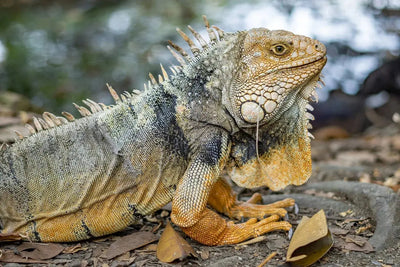Choosing the Right Lighting for Your Reptile

Choosing the right lighting for your reptile is essential for their health and well-being. Proper lighting not only provides the necessary heat and UVB rays for your pet's physiological processes but also contributes to their overall happiness. With a myriad of options available, selecting the best lighting for your reptile can be overwhelming. In this guide, we will explore the top 5 reptile lighting options that are essential for creating a comfortable and stimulating environment for your scaly companion. From UVB bulbs to basking lamps, we will delve into the features, benefits, and considerations for each lighting option, empowering you to make an informed decision for your pet's specific needs. Whether you're a seasoned reptile owner or a first-time enthusiast, understanding the importance of proper lighting and discovering the best options for your pet is key to fostering a thriving and contented reptilian companion.
Natural Lighting for Reptiles
Reptiles, like all living creatures, have specific needs to thrive in captivity. One crucial aspect of their care is providing natural lighting in their habitats. This section will delve into the importance of natural lighting for reptiles, its benefits, and tips for ensuring they receive adequate exposure to it.
Explanation of Reptiles' Need for Natural Lighting
Reptiles, being ectothermic, rely on external sources of heat to regulate their body temperature. Natural lighting, particularly UVB rays, plays a vital role in this process. UVB radiation aids in the synthesis of vitamin D3 in reptiles, which is essential for calcium metabolism and overall bone health. Without adequate exposure to UVB light, reptiles are at risk of developing metabolic bone disease, a debilitating condition that can significantly impact their quality of life.
Benefits of Natural Lighting for Reptiles
In addition to supporting vitamin D3 synthesis, natural lighting offers various other benefits for reptiles. Exposure to natural light helps regulate their circadian rhythms, promoting healthier sleep patterns and overall well-being. Furthermore, it can enhance the coloration and activity levels of certain reptile species, contributing to their overall vitality and visual appeal.
Tips for Providing Natural Lighting in Reptile Habitats
When setting up a reptile habitat, it's crucial to ensure that the lighting conditions mimic their natural environment as closely as possible. This can be achieved by using specialized UVB bulbs designed for reptiles, which emit the appropriate spectrum of light for their needs. It's essential to position these bulbs at the correct distance from the basking area to ensure that the reptiles receive optimal UVB exposure without the risk of overexposure. Additionally, providing a suitable photoperiod, or light-dark cycle, is essential for maintaining the reptiles' natural behavior and physiological processes. This involves simulating natural daylight hours and gradually dimming the light to mimic dusk and dawn.
UVB Reptile Lights
Explanation of UVB lights and their importance for reptiles
UVB lights are a crucial component of a reptile's habitat, especially for those that require exposure to natural sunlight in the wild. These lights emit ultraviolet B radiation, which is essential for reptiles to synthesize vitamin D3, a vital nutrient for calcium metabolism. Without adequate UVB exposure, reptiles can develop health issues such as metabolic bone disease, leading to deformities and even death. Therefore, providing the right UVB lighting is essential for the overall well-being of pet reptiles.
Overview of different UVB reptile lights available in the market
The market offers a wide range of UVB reptile lights, including fluorescent tubes, compact fluorescent bulbs, and mercury vapor bulbs. Each type has its own advantages and is suitable for different reptile species and enclosure setups. It's important for reptile owners to research and understand the specific lighting requirements of their pets to choose the most suitable UVB light for their habitat.
Factors to consider when choosing UVB reptile lights
When selecting UVB reptile lights, several factors need to be considered. These include the UVB output levels, the size of the enclosure, the specific needs of the reptile species, and the distance between the light source and the basking area. Additionally, the lifespan and energy efficiency of the UVB lights should also be taken into account to ensure long-term cost-effectiveness.
Common features and benefits of top UVB reptile lights
Top-quality UVB reptile lights often come with features such as a balanced UVB and UVA output, which closely mimics natural sunlight. They may also offer a broader light spectrum to support overall reptile health and behavior. Additionally, some lights are designed to emit minimal heat, reducing the risk of overheating in the enclosure. The benefits of using these lights include promoting natural behaviors, supporting proper calcium metabolism, and overall enhancing the well-being of pet reptiles.
Incorporation of relevant keywords from top search results
To ensure that this content is easily discoverable by reptile enthusiasts seeking information on UVB reptile lights, relevant keywords such as "UVB reptile lights," "best UVB lights for reptiles," and "UVB lighting for reptile habitats" will be strategically incorporated. This will help improve the visibility of this content in search engine results, making it more accessible to individuals seeking guidance on providing optimal lighting for their pet reptiles.
Basking Lights for Reptiles
Reptiles, like all animals, require specific environmental conditions to thrive. One crucial aspect of their habitat is the provision of adequate basking lights. In this section, we will explore the importance of basking lights for reptiles' thermoregulation, different types of basking lights and their features, tips for selecting the appropriate basking lights for different reptile species, and the incorporation of commonalities from top search results.
Importance of Basking Lights for Reptiles' Thermoregulation
Reptiles are ectothermic, meaning they rely on external sources of heat to regulate their body temperature. Basking lights play a vital role in providing reptiles with the necessary heat to maintain their metabolic processes. Without access to suitable basking lights, reptiles may struggle to thermoregulate effectively, leading to health issues such as poor digestion and compromised immune function.
Different Types of Basking Lights and Their Features
When it comes to basking lights for reptiles, there is a diverse range of options available. From halogen bulbs to ceramic heat emitters , each type of basking light offers unique features. Halogen bulbs, for example, emit intense, visible light along with heat, mimicking the effect of sunlight. On the other hand, ceramic heat emitters produce infrared heat without emitting light, making them suitable for use during the night.
Tips for Selecting the Appropriate Basking Lights for Different Reptile Species
Selecting the right basking lights for reptiles involves considering factors such as the species' natural habitat, size, and specific heat requirements. For desert-dwelling reptiles, basking lights that emit higher temperatures may be necessary, while species from more temperate regions may require lower-intensity heat sources. It's essential to research the specific needs of the reptile species in question to ensure their lighting requirements are met.
Incorporation of Commonalities from Top Search Results
By analyzing top search results, commonalities in the preferences for basking lights among reptile owners can be identified. This information can be valuable for individuals seeking guidance on the most popular and effective basking lights for their reptile companions. Common themes may include the preference for certain brands, specific wattages, or features that cater to a wide range of reptile species.
The Zilla Basking Platform Filter Small, available on talis-us.com, offers a wide range of pet supplies, including products designed specifically for reptiles. While the specific features of the Zilla Basking Platform Filter Small are not detailed, the webpage caters to pet owners seeking high-quality supplies for various animals. Understanding the diverse range of basking lights available and their specific features is crucial for reptile enthusiasts looking to create optimal habitats for their pets.
Heat Lamps for Reptiles
Explanation of heat lamps and their role in reptile habitats Heat lamps play a crucial role in maintaining the well-being of reptiles in captivity. Reptiles, being cold-blooded animals, rely on external heat sources to regulate their body temperature. In their natural habitats, they bask under the sun to absorb warmth. In captivity, heat lamps simulate this natural sunlight, providing reptiles with the necessary heat to support their metabolic processes and overall health.
Overview of Different Types of Heat Lamps Available for Reptiles
When it comes to heat lamps for reptiles, there are various options to choose from. The most common types include incandescent bulbs, ceramic heat emitters , and mercury vapor bulbs. Each type serves a specific purpose, such as providing heat, infrared light, or UVB radiation. Understanding the differences between these lamps is essential for creating a suitable and comfortable environment for reptiles.
Factors to Consider When Choosing Heat Lamps for Reptiles
Selecting the right heat lamp for reptiles involves considering several factors. These include the species of reptile, the size of the enclosure, and the specific heating requirements. For instance, desert-dwelling reptiles may require higher temperatures compared to those from tropical regions. Additionally, the distance between the lamp and the basking spot needs to be carefully regulated to prevent overheating or inadequate warmth.
Tips for Positioning Heat Lamps in Reptile Enclosures
Proper positioning of heat lamps is crucial for creating temperature gradients within the enclosure. This allows reptiles to move between warmer and cooler areas as needed. Placing the heat lamp at one end of the enclosure creates a basking spot, while the opposite end remains cooler, mimicking the natural temperature variations found in the wild. It's important to regularly monitor and adjust the positioning of the heat lamp to ensure optimal temperature distribution.
Mention of Safety Precautions While Using Heat Lamps
While heat lamps are essential for reptile care, they also pose potential risks if not used carefully. It's important to use fixtures and bulbs specifically designed for reptile habitats to prevent overheating and fire hazards. Additionally, installing protective guards around the heat lamps can prevent reptiles from coming into direct contact with the hot surfaces, reducing the risk of burns.
LED Lighting for Reptiles
LED lighting has become increasingly popular among reptile owners due to its energy efficiency, longevity, and customizable features. In this section, we will explore the benefits of using LED lights for reptile habitats and the different types of LED lights suitable for various reptile species.
Benefits of LED lights for reptiles
- LED lights offer several advantages for reptile habitats.
- They produce minimal heat, which is crucial for maintaining the optimal temperature in the enclosure without overheating the reptiles.
- LED lights provide a full spectrum of light, including UVB and UVA, essential for the overall well-being and natural behavior of reptiles.
- These lights also have a longer lifespan compared to traditional lighting options, reducing the frequency of replacements and maintenance.
Different types of LED lights suitable for reptile habitats
- There are various types of LED lights designed specifically for reptile habitats.
- Some are tailored for specific reptile species, such as desert-dwelling reptiles that require higher UVB output, while others are suitable for tropical or forest-dwelling species.
- It's important for reptile owners to choose LED lights that cater to the specific lighting and heating needs of their pets based on their natural habitat.
Incorporation of keywords from top search results
- When searching for LED lighting for reptiles, it's essential to consider the keywords commonly used in top search results.
- This ensures that reptile owners can find the most relevant and reliable information when selecting LED lights for their pets.
- By incorporating these keywords, we can help reptile enthusiasts navigate through the vast array of options and make informed decisions about their lighting choices.
Common features and advantages of top LED reptile lights
- Top LED reptile lights often share common features that make them stand out in the market.
- These may include adjustable brightness and color temperature settings, built-in timers for simulating natural day-night cycles, and energy-efficient designs.
- Understanding these common features can assist reptile owners in selecting the most suitable LED lights for their specific reptile habitats.
Additional Lighting Options for Reptiles
Reptiles, like any other pets, require proper lighting to thrive in their habitats. While the Zilla Micro Reptile and Amphibian Habitats Arboreal on Talis US offers a wide range of habitats and supplies, it's essential to explore additional lighting options to ensure the well-being of your reptile friends.
Brief Overview of Additional Lighting Options
In addition to the standard lighting options provided by Zilla, there are other specialized lighting options available for reptiles. These include UVB lighting, basking bulbs, and infrared heat lamps. Each of these serves a specific purpose in replicating the natural environment of reptiles and providing the necessary light and heat for their physiological processes.
Explanation of Their Specific Uses and Benefits
- UVB Lighting: UVB lighting is crucial for reptiles as it helps in the synthesis of vitamin D3, essential for calcium metabolism and preventing metabolic bone disease.
- Basking Bulbs: Basking bulbs mimic the warmth of the sun, providing a localized heat source for reptiles to regulate their body temperature.
- Infrared Heat Lamps: Infrared heat lamps emit infrared light, which penetrates the skin and aids in promoting blood circulation and overall well-being.
Tips for Integrating Multiple Lighting Options in Reptile Habitats
Integrating multiple lighting options in reptile habitats can be beneficial for creating a dynamic and naturalistic environment. It's important to position the lighting sources strategically to create temperature and light gradients within the habitat. For example, placing the basking bulb over a specific area for sunbathing while ensuring UVB lighting covers the entire habitat for overall exposure.
Conclusion
In conclusion, while the Zilla Micro Reptile and Amphibian Habitats Arboreal on Talis US provides an extensive range of products, it's essential for reptile owners to consider additional lighting options to meet the specific needs of their pets. Understanding the uses and benefits of different lighting options and integrating them effectively can contribute to the overall well-being and vitality of reptiles in captivity.
Reptile Lighting Options
In conclusion, choosing the right lighting option is crucial for the well-being and happiness of your reptile pet. Whether it's UVB lighting, basking bulbs, or ceramic heat emitters, providing the appropriate lighting is essential for their health and behavior. With the wide range of products available, it's important to select the best options for your specific reptile species. To explore a comprehensive range of habitats, ornaments, and lighting options for your reptile pet, visit Talis US at Zilla Micro Reptile and Amphibian Habitats Arboreal . Your pet's well-being is worth the investment.






